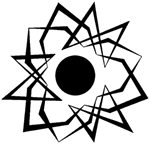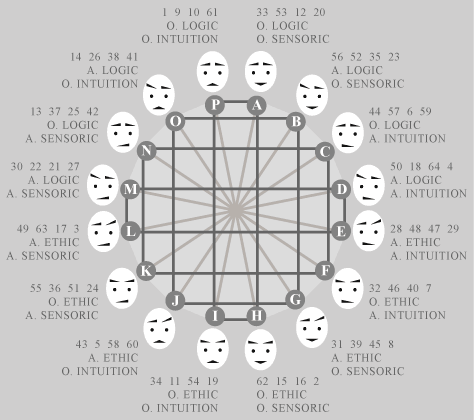|
Page 9. |
 |
The ninth page compares hexagrams i-jing to physiognomic symbols of functional types of analytical psychology, and also describes interrelations of functional types in rings. |
-
Psychological types of analytical psychology can be identified according to
physiognomic parameters of eyes that specifies extraversion or introversion. And
also according to physiognomic parameters of eyebrows and mouths that specifies
rational mental functions which are the logics and ethics, or irrational mental
functions which are intuition and sensory. But according to ratio of
psychological types with hexagrams of the Book of Changes i-jing in rings it is
possible to not consider physiognomic parameters of eyes, and it is possible to
consider only physiognomy of mouths and eyebrows. As parameters of eyes in each
ring are identical.
Namely interrelations of psychological types in rings correspond to lines or
otherwise to tell to aspects which specify parities of groups, instead of
separate types, but in groups it is impossible to consider physiognomic
parameters of eyes, that is possible to see on the scheme on the previous page.
For example, 50, 18, 64, 4 psychological types within four rings form group, or
27, 21, 22, 30 psychological types form group. If to analyze parities of these
groups it is impossible to consider physiognomic parameters of eyes.
Therefore it is possible to apply the following reduced scheme.
 |
Physiognomic symbols on the scheme correspond to
functional types of analytical psychology that differs from
psychological types as in this case there are only physiognomic
parameters of mouths and eyebrows which correspond with mental
functions, namely correspond with logics, ethics, sensory, intuition,
and there are no physiognomic parameters of eyes. Each functional type unites four psychological types. For example, functional type A unites 33, 53, 12, 20 psychological types. White letters in dark circles are indications of functional types. And also the scheme shows conformity of physiognomic parameters and mental functions. For example, eyebrows correspond to active logic, and the mouth corresponds to obvious sensory in the physiognomic symbol of functional type B. |
-
The shown scheme allows to see interrelations of functional types, and also
corresponding psychological types of analytical psychology.
Letters AHIP designate a vertical of harmonious functional types at which both
mental functions are obvious.
Letters DELM designate a horizontal of contrast functional types at which both
mental functions are active.
Letters BCJK and FGNO designate diagonals of explicit functional types at which
one mental function is obvious, and the second mental function is active.
The detailed information on functional
types of analytical psychology look in other section of this website.
Harmonious functional types and corresponding psychological types have
harmonious interrelations with other types as obvious mental functions
counterbalance functions of other types.
Contrast functional types have contrast interrelations as active mental
functions do not counterbalance functions of other types.
Explicit functional types have complex interrelations as active mental functions
do not counterbalance, and obvious mental functions counterbalance functions of
other types.
For example.
Functional types A and H have harmonious interrelation as all mental
functions are obvious.
Functional types A and D have harmonious interrelation as obvious mental
functions of type A counterbalance active functions of type D.
Functional types D and M have the coordinated interrelation according to
rational mental functions as both of type possess active logic, but have the
uncoordinated interrelation according to irrational mental functions as one type
possesses active intuition, and the second type possesses active sensory.
Functional types D and B have the coordinated interrelation according to
rational mental functions as both of type possess active logic, and have
harmonious interrelation according to irrational mental functions as obvious
sensory of type B counterbalances active intuition of type D.
Functional types B and J have the uncoordinated interrelation according
to rational mental functions as one type possesses active logic, and the second
type possesses active ethics, but have harmonious interrelation according to
irrational mental functions as intuition of type J and sensory of type B are
obvious.
And also other functional types have similar interrelations which can be seen
within the shown scheme.
I hope that the resulted information will be actual for analyses of human
mutual relations in a context of analytical psychology.
And also I hope that there will be actual all complex of information in this
site section about circles and rings according to which hexagrams of the Book of
Changes i-jing correspond with aspects of astrological circle and numerology of
a magic square, and also correspond with psychological structures of a human
personality.
Except for circles and rings it is possible to organize hexagrams i-jing in spheres about which look the information on pages of this website in section which has the name chronology where symbols of the Book of Changes i-jing are compared to various calendars and chronological cycles of time.
-